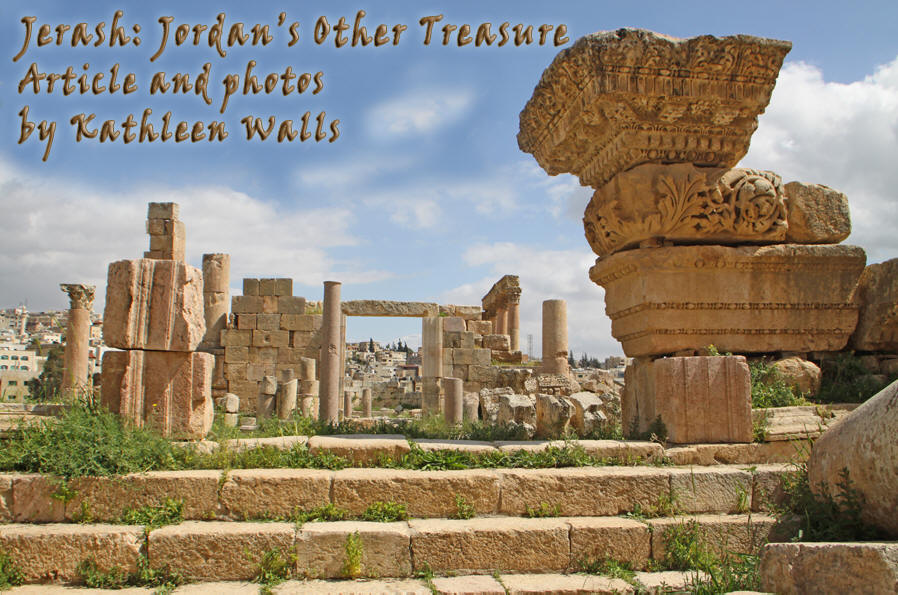
Can you imagine stepping back to a
civilization that flourished back in 331BC? The ancient ruins of
Jerash in Jordan were founded about that date by
Alexander the Great or one of his generals. When I visited, I
could feel the currents of civilization that had flourished in
these ancient streets and buildings.
My first glimpse was of Hadrian's Arch. It
towered out of the landscape like an entrance to an ancient
world. That
entrance beckoned me so I could hardly keep from rushing through
the gates long enough to listen to our guide, Mohammed, give us
some background on the ruins. Good thing I made myself pay
attention. Mohammed indicated the remnants of the wall some
distance into the site. He told us "more than half of the
ancient city lies outside of the main walls of this old Roman
city and is buried underground beneath the new city." He pointed
to the modern city adjourning the walls filled with modern day
buildings and apartments.
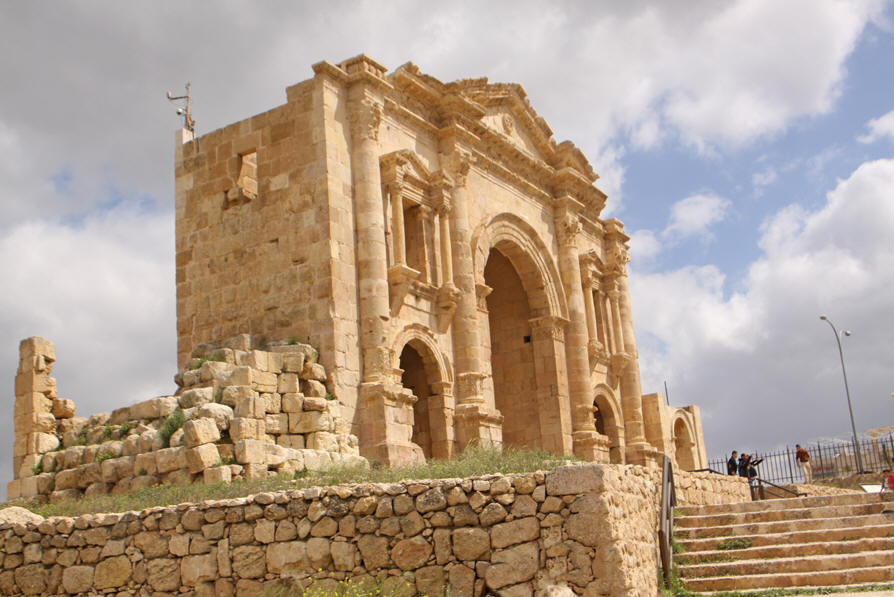 |
| Hadrian's Gate |
He then led us through Hadrian's Arch. It
was built in 129 BC in honor of the popular emperor's visit to a
city that was already old. Hadrian was, like many of us, an
inveterate traveler. He visited every province in his empire
which stretched from England to Egypt. As I stepped under that
arch on the remains of the old Roman road, I felt a connection
as if I were standing in the spot Hadrian's sandals had also
stood.
Before we reached the Roman wall of the
city, we stopped to admire the Hippodrome where the Roman games
took place. It was outside the city walls because, just like
with today's unruly football fans, it was deemed safer to
confine the noisy crowd outside the actual residential part of
the city. But the Hippodrome was not the first sporting site
here. The Romans came in and built it on top of the site of a
Greek race track.
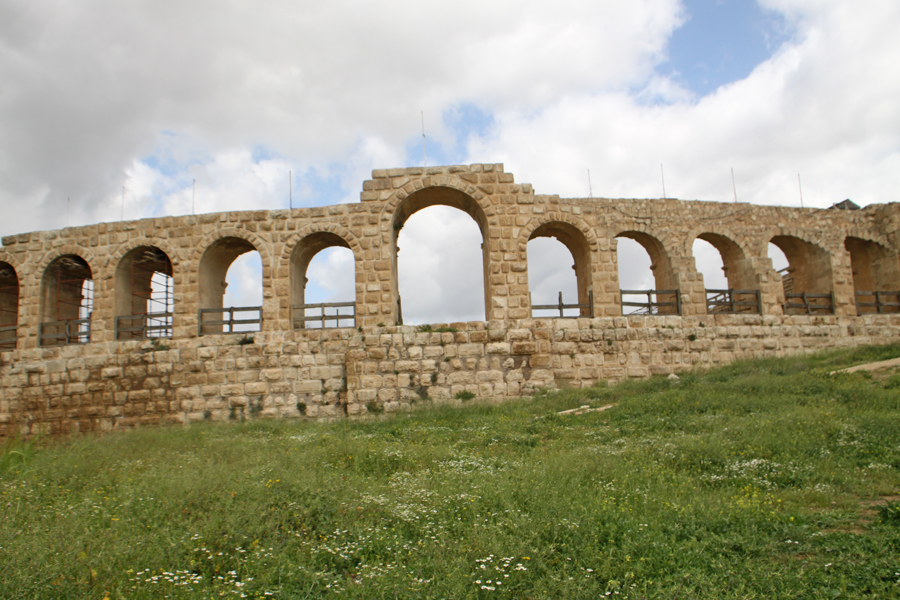 |
| Hippodrome |
The early Greek name of the city was
Gerasmenos meaning "aged Macedonian soldiers" who were the
original settlers the Greeks placed there. Roman conquest in
63bc by Emperor Pompey changed the style of the city as well as
the name to Gerasa. Romans built on the Greek ruins,
appropriated the temples, added new roads and made it Roman.
They decided Jerash was to be included in it Decapolis Cities,
ten important centers they established in the Palestine region.
They played politics to change the trade route from the
Nabataean city of Petra (yes, you have to see Petra, too) and
have it run through Jerash instead. Naturally these caravans
brought a lot of money and contact with many cultures to Jerash.
 |
| Theater with Musician ready to
entertain. |
Although Jerash is known as one of the best
preserved Roman cities outside of Rome, A recent discovery made
by the University of Jordan's archeological team of two human
skulls, date the site back to the Neolithic period (7500-5500
BC.) The Greeks may have founded the city but they were not the
first to settle there.
 |
| Forum |
After we entered the city gates, Mohammed
showed us a site where we could see traces of the civilizations
who had built on what was once a Neolithic city.
He pointed to a
structure where we could see a difference in the stone work and
explained how to distinguish what each culture built on upon the
other. The top part of the wall was large stones, Roman
construction. Just below was a section of smaller cut stone, the
Greek style. Below that was a small crude style of stone dated
back to an earlier Arab people who had begun the original wall.
We stopped at one place where I picked up a piece of the shards
of Roman pottery that lay all over the ground; Mohammed
commented "This is where you touch history."
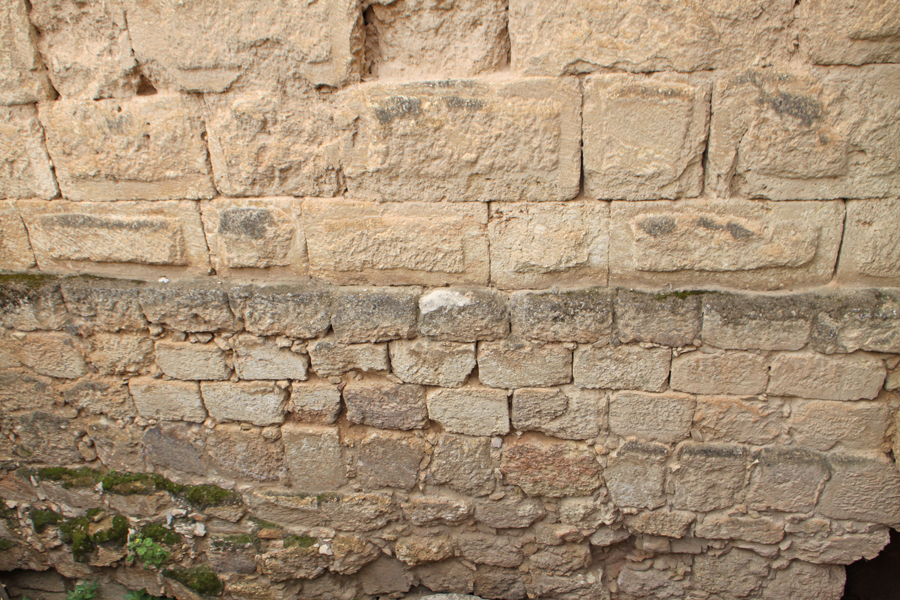 |
| Notice the difference in stone
work |
Religions over the ages are represented
here. I was equally thrilled by the sight of the huge columns of
the Temple of Artemis and Zeus and the mosaic still visible in
the ruins of a Byzantine church.
 |
| Zeus Temple |
The advanced technology of the Romans when
it came to uses of water is seen at the Nymphium, a well
preserved ornamental fountain dating to 191 AD dedicated to the
Nymphs, or water goddesses.
 |
| Nymphium |
The Colonnaded Streets amazed me. They are
so straight and look better preserved than some streets I have
driven on present day. I could see the chariot tracks worn down
into the cobblestones.
 |
| Colonnaded Street |
Jerash began its downward slide when the
Persians invaded in 614 AD. Then in 749 AD there was a major
earthquake. When the
Crusaders arrived to "rescue" the city, they converted many of
the ancient buildings into fortresses. They described it as an
abandoned city. Sand covered much of the site until modern times
when excavation begun in 1927 and began to unearth this hidden
treasure. Not even half of Jerash had been excavated.
I can't help but wonder what might be forever hidden
beneath the modern city.
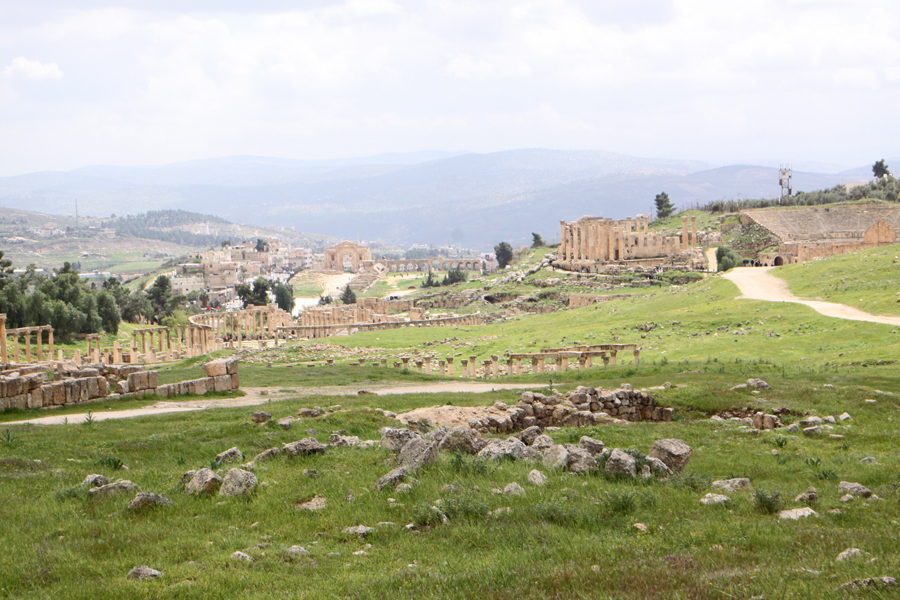 |
| Overview of Jerash, the ruins
and the town in background |
Jerash's remote location helped protect it
from having the stones reused to build modern buildings. It is
about 45 minutes from Amman and fast becoming almost as popular
as Petra.
For
more info:
http://international.visitjordan.com/Wheretogo/Jerash.aspx
Getting there: I suggest Royal Jordanian Airlines.
http://www.rj.com/en
American Roads and
Global Highways has so many great articles you may
want to
search it for you favorite places or new exciting destinations.
|